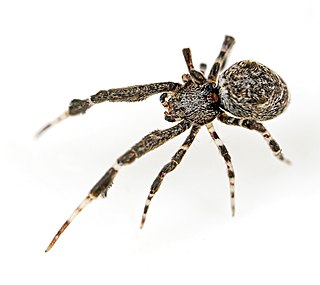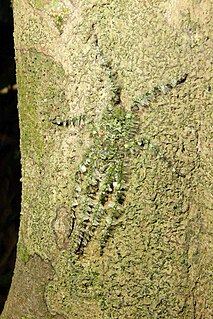
Huntsman spiders, members of the family Sparassidae, are known by this name because of their speed and mode of hunting. They are also called giant crab spiders because of their size and appearance. Larger species sometimes are referred to as wood spiders, because of their preference for woody places. In southern Africa the genus Palystes are known as rain spiders or lizard-eating spiders. Commonly they are confused with baboon spiders from the Mygalomorphae infraorder, which are not closely related.

Nephila is a genus of araneomorph spiders noted for the impressive webs they weave. Nephila consists of numerous species found in warmer regions around the world. They are commonly called golden silk orb-weavers, golden orb-weavers, giant wood spiders, or banana spiders.

Trichonephila clavata, also known as the Jorō spider, is a member of the golden orb-web spider genus. The spider can be found throughout Japan, in Korea, Taiwan, China, and more recently, northeast Georgia in North America. Due to the large size as well as the bright, unique colors of the female Trichonephila, the spider is well-favored in Japan.

Trichonephila clavipes, commonly known as the golden silk orb-weaver, golden silk spider, or banana spider, is an orb-weaving spider species which inhabits forests and wooded areas ranging from the southern US to Argentina. In fact, it is the only species of the genus Trichonephila indigenous to continental North and South America. Known for the golden color of their silk, the large size of their females, and their distinctive red-brown and yellow coloring, T. clavipes construct large, asymmetrical circular webs attached to trees and low shrubs in woods to catch small- and medium-size flying prey, mostly insects. They are excellent web-builders, producing and utilizing seven different types of silk, and they subdue their prey by injecting them with venom, as opposed to related species which immobilize their prey by wrapping them in silk first. They are not known to be aggressive towards humans, only biting out of self-defense if touched, and their relatively harmless venom has a low toxicity, posing little health concern to healthy human adults. Due to their prevalence in forests, T. clavipes may be encountered by hikers.

Uloborus is a spider genus in the family Uloboridae with 72 described species. Most species occur in the tropics and subtropics, with only few species in northern America and Europe.

Trichonephila edulis is a species of large spider of the family Araneidae, formerly placed in the genus Nephila. It is referred to the common name Australian golden orb weaver. It is found in Australia, in both tropical and temperate regions, and in parts of New Guinea and New Caledonia.

Uloborus plumipes is a species of Old World cribellate spider in the family Uloboridae. Common names include the feather-legged lace weaver and the garden centre spider, the latter name being due to its frequent occurrence of this spider in garden centres on the world. The species name is derived from the Latin pluma "feather" and pes "foot".
The genus Selenotypus includes one of the largest of Australia's theraphosids. At present, the only recognised species within this genus is Selenotypus plumipes, but this is expected to change, as it is becoming apparent that the genus has a wide distribution, and at present Australian theraphosids as a whole are poorly classified.

Yule Island is a small island in Central Province, Papua New Guinea. It is located 160 km NW from Port Moresby, on the south coast of Papua New Guinea.

Trichonephila plumipes is a species of spider found in Australia, Indonesia and some Pacific Islands, which exhibits extreme sexual dimorphism through its sexual cannibalism behavior. It is sometimes called the tiger spider due to its markings which look similar to a tiger. This species was formerly called Nephila plumipes. As with other spiders from the genus Nephila, these spiders have a distinct golden web.

Pandercetes gracilis, also called the lichen huntsman spider and the lichen spider, is a huntsman spider found on New Guinea, the Maluku Islands, Sulawesi, and in Queensland, Australia. Individuals can vary in color and many color forms exist, but unlike squids and certain reptiles, color is fixed at its previous molt. It hunts by hiding among moss and lichen, then ambushing prey that comes into range by pouncing on it.
P. gracilis may refer to:

The hairy-footed flower bee is a species of bee belonging to the family Apidae.

Tapinauchenius is a genus of tarantulas that was first described by Anton Ausserer in 1871. The name is a combination of the Greek ταπεινός, meaning "low", and αὐχήν, meaning "neck". Several species, including T. gigas, have been moved to Pseudoclamoris.

Pandercetes is a genus of huntsman spiders that was first described by Ludwig Carl Christian Koch in his 1875 treatise on Australian spiders. They are mainly distributed in tropical Asia and Australia, and are known for their cryptic coloration that matches local moss and lichen. Their legs have lateral hairs, giving them a feathery appearance, further masking their outline against tree trunks. Their head is somewhat elevated and the carapace has the thoracic region low and flat.
Pandercetes decipiens, is a species of spider of the genus Pandercetes. It is native to India and Sri Lanka.
Evippomma is a genus of spiders in the family Lycosidae. It was first described in 1959 by Roewer. As of 2017, it contains 6 species.

Argyrodes antipodianus, also known as the dew drop spider, is a species of kleptoparasitic spider from the cobweb spider family found in Australia, New Zealand and New Caledonia.













